Products
AVG Controllers
Accessible Active Video Game Controllers
Active video games (AVGs), a category of video games that require whole-body movements, hold promise for promoting higher levels of physical activity, weight management, and fitness among youths. However, many current AVGs are inaccessible or offer limited play options for youths who are unable to stand, have balance issues, poor motor control, or cannot use their lower body to perform game-required movements. RecTech has partnered with the UAB School of Engineering and developed several prototypes from 2014 to 2019.
Wii Mat
Barriers that were identified with the Wii Mat in Phase I were related to sensitivity, spread of buttons, and safety for children with balance and/or coordination difficulties. The adapted Wii Mat system is similar in design to the standard mats currently available on the market in that it includes eight low-profile buttons that correlate to the buttons of the Wii handheld controller. The adaptations allow gameplay with both hands and feet and provide increased sensitivity through the use of piezoresistive sensors and an integrated microcontroller – an example of the sensor configuration and a similar DIY sensor are shown below. The system has eight separate buttons that are spatially reconfigurable, allowing the user to place the buttons in any configuration to meet their specific preferences better.
WiiFit Board
The original Wii Fit Board presented challenges for users with mobility limitations; it was too small for those with balance difficulties and inaccessible for wheelchair users. To address these barriers, the adapted Wii Fit Board was developed as a larger, more stable platform that incorporates the original electronics while improving safety, responsiveness, and usability. Key adaptive features include:
- Ramp access for easy entry and exit
- Lighted alignment grids to guide wheelchair positioning
- Sensitivity adjustments tailored to each player’s functional abilities
- Front and back guards to prevent wheelchairs from rolling over
- Adjustable front guard to fit various footrest designs
- Height-adjustable handrails for added support and protection
- Accessible start button within easy reach
- Alternative input for jumping actions, such as pressing a button instead of leaving the board
GaimPlank
GaimPlank was developed based on the success of the previous prototype of the Adapted Wiifit board. The RecTech team developed the sensors for the board instead.
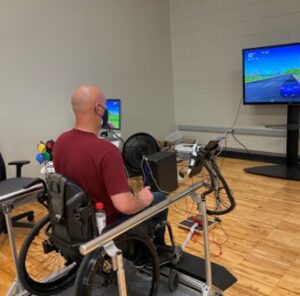
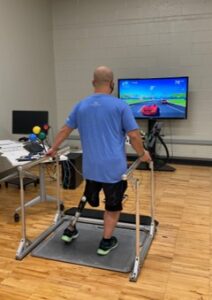
“I like the board because I get to move with my body versus just sitting down. Gets me up instead of just using the phone. This gaming board encourages body movement.”
[AVG011, walks without an assistive device, played standing]
Touchpads
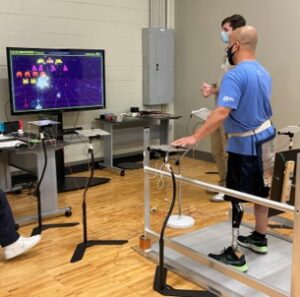
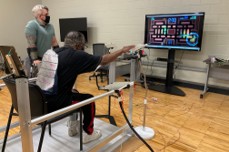
“I like the touch pads because I was able to use my impaired limb during play.”
[Woman, 42 years, poststroke]
Touchpads are large, interactive targets that translate physical contact into video game commands. They can detect input from skin contact (hand or forearm) or conductive materials (such as a backpack, sleeve, or glove). Designed with strategic layouts, touchpads encourage player movement and physical activity while maintaining engagement.
Their versatile design makes them adaptable for players of varying abilities and compatible with a wide range of video games. The large surface area helps participants stay focused on gameplay. Each touchpad connects to a Makey Makey© device, which converts input into keyboard presses. Recognized as a USB controller on both PC and Mac, this setup ensures broad accessibility across most video games.
Related videos
Related Publications
The Usability of a Touchpad Active Video Game Controller
AIMS
AIMS – Activity Inclusion Mapping System
What is AIMS?
AIMS (Accessible Inclusive Mapping System) is an online tool developed by RecTech in 2009 that helps people find accessible and inclusive fitness opportunities in the community. It provides a first-of-its-kind directory of local fitness and recreation facilities, each evaluated through an in-depth accessibility survey. The system highlights not only whether facilities are accessible, but also what inclusive adaptations are offered for specific activities. The prototype was developed for Jefferson and Shelby counties in Alabama.
How does AIMS work?
The search features of AIMS are designed to be user friendly, allowing people to quickly and easily discover if: a) facilities are accessible, b) what activities they offer, and c) if these activities offer inclusive adaptations. To do this, from the home page, users select their preferred fitness activity from the AIMS directory. Users can further filter their searches by location or specific building features they desire (ex, accessible doors, accessible bathroom stall, accessible pool, etc).
Related video
AIMFREE
AIMFREE – Accessibility Instruments Measuring Fitness and Recreation Environments
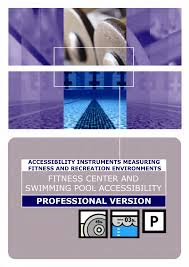
The AIMFREE instruments were developed by NCHPAD (CDC-funded) in 2000 to measure the accessibility of fitness and recreation facilities for persons with mobility impairments (e.g., persons using wheelchairs or other assistive devices). The AIMFREE instrument contains about 400 questions and 15 sections. Efforts were also made to include items that were relevant to persons with other disabling conditions, including individuals with sensory impairments (e.g., size of print on facility signage). Instrument development occurred in three phases: (1) setting selection, which involved identifying the types of fitness and recreation facilities of greatest interest to persons with disabilities; (2) item development; and (3) instrument piloting.
RecTech revised the AIMFREE instrument around 2009 and collected data from fitness facilities across the US.
Related Video
Related Publications
Development and validation of AIMFREE
Fitness facilities still lack accessibility for people with disabilities
An Advanced Virtual Environment Exercise Device AVE(2)D
An Advanced Virtual Environment Exercise Device (AVE2D) for Promoting Socially Engaging Physical Activity in People with Disabilities
RecTech, in partnership with PushProduct Design, LLC, has developed and tested a successful prototype of AVE2D from 2014 to 2020. This phase effort has developed and constructed an advanced control system to act as the foundation to enable AVE2D to provide exercise conditioning for users with asymmetric capabilities (eg, stroke survivors). This effort has been specifically focused on addressing key gaps in the market that current equipment often does not address, e.g., allowing the user’s “weak” side or limb axis to be adequately conditioned.
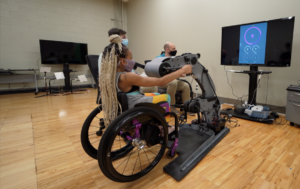
Figure. Latest prototype with an advanced control system, including asymmetric upper axis resistance control and augmented power to the leg axis.
Participant feedback after 24 AVEED sessions: “It was fun. I enjoyed it and I think I got some benefits that I’m sure I know it did because, been able to do a little more movement to step my arm than I normally been doing and things like that, but it was all enjoyable to me….You know you changing scenery and stuff and then just makes it interesting. Now, if I was just peddling on a blank screen, it wouldn’t be a bit fun.”
The control system can provide specific right and left side resistance and cadence-related settings “tuned” to particular conditions. The control system can also provide supplemental power to the leg axis for individuals with a range of potential exercise needs (e.g. incomplete SCI who could benefit from leg-related exercise in a recumbent or standing position).
Gaming Platform: Racing With Myself (RYM)
The “Racing With Myself (RYM)” game is designed to support stroke rehabilitation by promoting balanced movement between both arms during two-arm, split crank cycling. Each arm crank controls a separate cycling avatar, challenging participants to keep both arms moving at the same speed.
- Target group: Participants post-stroke
- Gameplay goal: Match the speeds of both arms to achieve perfect parity
- Scoring system: Points are awarded based on speed parity, with 100 points representing equal performance between the left and right arm
This engaging gaming platform helps participants minimize interference from the nonparetic arm while encouraging active involvement of the paretic arm, making rehabilitation both motivating and interactive.
Push PD, LLC filed a provisional patent with the US Patent Office (based on Push’s experience with securing intellectual property for corporate clients) to create maximum value for potential strategic commercialization partners.
Related Videos
Related Publication
Energy Expenditure Estimator
What is EE_estimator?
EE_estimator is a computer application designed for estimating energy expenditure of manual wheelchair users with spinal cord injury (SCI) using the commercial activity monitor SenseWear armband (Bodymedia, Inc., Pittsburgh, PA) from 2011 to 2014. This application uses the personal information (e.g., height and weight) of a manual wheelchair user with SCI, along with the raw data collected by the SenseWear armband, to provide a more accurate estimate of his/her energy expenditure as compared to the default outputs from the SenseWear armband. To use this application, you should have access to the raw data collected by the SenseWear armband, typically through the SenseWear Professional Software.
Why is EE_estimator developed?
The SenseWear armband was designed initially for estimating physical activity and energy expenditure of the ambulatory population. Research has shown that the SenseWear armband is not accurate at tracking physical activity and energy expenditure in manual wheelchair users with SCI (1, 2). Therefore, our research team has created this application that uses custom models for manual wheelchair users with SCI derived from our research (3) to enable people who are interested in using SenseWear armbands for wheelchair users to obtain an accurate estimate of energy expenditure.
How was this application developed?
Our research team has developed two types of custom energy expenditure models, i.e. the general and the activity-specific models. The general model can be used when you do not have a log of activities performed by the wheelchair user. The activity-specific model can be used for four activities, including resting while seated, light-weight deskwork (e.g., computer operation, reading, etc.), wheelchair propulsion, and arm-ergometry exercise. Both models were developed using data collected from 45 manual wheelchair users with SCI. Participants were asked to wear a SenseWear armband and a portable metabolic cart (gas analyzer) while performing the four activities mentioned above in the laboratory setting. More details about the modeling process can be found in (3).
How accurate is this application?
We evaluated the two custom models with another group of 45 manual wheelchair users with spinal cord injury who performed a wide range of lifestyle and sporting-based activities in both laboratory and home/community settings. Eighteen out of the 45 wheelchair users have participated in our previous study mentioned above. Overall, the general model has an average percent error of -2.8±26.1%, while the activity-specific model has an average percent error of -4.8±25.4% when compared to the portable metabolic cart readings. More information on the validity study can be found in (4, 5). It should be noted that both models were developed and tested among manual wheelchair users with SCI. We do not know how the models will perform when they are applied to manual wheelchair users with other diagnoses.
Related Video
Relevant Publications
Predicting energy expenditure of manual wheelchair users
Evaluation of activity monitors in manual wheelchair users with paraplegia
Contact Information
If you are interested in using the EE_estimator application, please share your project information and contact details with us. We will follow up with you and send you the application. If you have any questions about using this application, please feel free to contact the Project Director, Dr. Dan Ding, at dad5@pitt.edu. This work is supported by the RERC on Interactive Exercise Technologies and Exercise Physiology for Persons with Disabilities (#H133E120005) funded by the National Institute on Disability and Rehabilitation Research (NIDRR). The Human Engineering Research Laboratories, VA Pittsburgh Healthcare System, also support the work. The contents do not represent the views of the Department of Veterans Affairs or the United States Government.
References
- Hiremath S, Ding D. Evalution of activity monitors in manual wheelchair users with paraplegia. Journal of Spinal Cord Medicine. 2011;34(1):110-7. doi: 10.1179/107902610X12911165975142.
- Hiremath SV, Ding D, Evaluation of Activity Monitors in Estimating Energy Expenditure in Manual Wheelchair Users. RESNA Annual Conference; 2010; Las Vegas, Nevada.
- Hiremath S, Ding D, Farringdon J, Cooper RA. Predicting Energy Expenditure of Manual Wheelchair Users with Spinal Cord Injury Using a Multisensor-Based Activity Monitor. Achives of Physical Medicine and Rehabilitation. 2012;93(11):1937-43. doi: 10.1016/j.ampr.2012.05.004.
- Tsang KL, Hiremath SV, Ding D. Evaluating the Energy Expenditure Prediction Models for Manual Wheelchair Users with Spinal Cord Injuries. RESNA Annual Conference; Indianopolis, Indiana2014.
- Tsang KL, Hiremath SV, Ding D. Evaluation of the Energy Expenditure Prediction Models for Tracking Physical Activity in Manual Wheelchair Users. Journal of Rehabilitation Research & Development. 2014; In Review.
FitWithUs Platform
FitWithUs Platform
FitWithUs is a multimodal tele-exercise platform designed for individuals with disabilities. This platform was developed by RecTech (2022-2024) and is currently enrolling participants with mobility limitations for the intervention study. Participants in this study can access adapted exercise videos, health coaching, one-on-one or group fitness training, reminder emails, text messages, and activity monitoring (via Fitbit) through this platform. For more details, check fitwithus
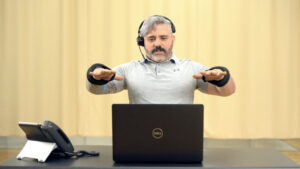
FrameRunner
FrameRunner
FrameRunner is an adaptive three-wheeled mobility device designed to empower individuals, especially those with balance or mobility impairments, to run or walk independently. RecTech, in collaboration with Motivation (2022-2025), has developed a framerunner that offers versatile sizing, customizable support, and stability features for users of all ages. With large wheels suitable for both track and off-road use, safety steering bands, and adjustable components, it ensures a comfortable and controlled ride. Its quick-release wheels, foldable frame, and dual axle positions make it easy to store, transport, and adapt for multiple users. For more details on Motivation and FrameRunner, click here
Para-Percussion
Para-Percussion: Rhythmic Exercise for the Body and Mind
Exercise is recognized as one of the most important behaviors in maintaining overall health and reducing the risks of chronic diseases,1,2 as well as protecting against secondary conditions.3 For persons with disabilities, studies have demonstrated that exercise improves functional performance,4 and quality of life.5 Musical performance is an art form that has shown to be a highly effective method for increasing the amount of physical activity one performs each day.6 With a lack of resources able to accommodate the high demand for personal musician trainers, it is often difficult or impossible for users to advance their skills.
Para-percussion technology approaches this problem with automated systems and unique assemblies to accommodate users of all kinds. The idea is simple – give users a system that allows for interactive and instructional rhythmic content, while keeping the system easy to follow and universally accessible. The current model of Para-percussion integrates Arduino microcontroller systems with an adjustable percussion rack unit (examples shown below), currently allowing for simple patterns and rudiments to be learned and practiced.
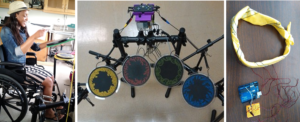
Example of a microcontroller used, and initial assembly
Features of this model include time mapping algorithms for forgiving pattern recognition, complete adaptability for users with varying ranges of movement and ability, 3D printed circuitry enclosures for unique and sturdy assembly, lighted drums for aesthetically pleasing visual recognition, and wireless communication with vibrating modules to allow haptic feedback for users with little to no sight.
References
1. U.S. Department of Health and Human Services. (1996). Physical Activity and Health: A Report of the Surgeon General. Atlanta, GA: U.S. Department of Health and Human Services, Centers for Disease Control and Prevention, National Center for Chronic Disease Prevention and Health Promotion.
2. U.S. Department of Health and Human Services. (2000). Healthy People 2010. Washington, DC: U.S. Department of Health and Human Services.
3. Paffenbarger RS, Morris JN, Haskell WL, Thompson PD, Lee I-M. (2004). An introduction to the Journal of Physical Activity and Health. J Phys Activity Health, 1:1–3.
4. Romberg A, Virtanen A, Ruutiainen J, Aunola S, Karppi SL, Vaara M, Surakka J,Pohjolainen T, Seppanen A. (2004). Effects of a 6-month exercise program on patients with multiple sclerosis: a randomized study. Neurology, 63(11):2034–2038.
5. Patti F, Ciancio MR, Reggio E, Lopes R, Palermo F, Cacopardo M, Reggio A. (2002). The impact of outpatient rehabilitation on quality of life in multiple sclerosis. J Neurol, 249(8):1027–1033.
6. University of Chichester, “The Clem Burke Drumming project,” July 2008. Web.
http://www.clemburkedrummingproject.com/Research.html.
PE Inclusion Solution
PE Inclusion Solution
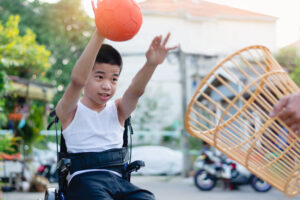
Developed by RecTech (2022–2025), PE Inclusion Solutions is a crowdsourced platform where educators, parents, and researchers share and access practical strategies for inclusive physical education and sports. At its core is the LIRSPE tool, which helps teachers, para-educators, and parents quickly identify barriers and receive instant solutions to foster more inclusive PE experiences. By supporting diversified instruction, adapted equipment, and inclusive teaching practices, we work to reduce social isolation, enhance academic outcomes, and ensure that all students, particularly those with disabilities, can participate safely and meaningfully in physical education.
To learn more, click here.
Published Standards and Test Methods
Standard Test Method for Evaluating the Universal Design of Fitness Equipment for Inclusive Use by Persons with Functional Limitations and Impairments has been developed by RecTech in partnership with Beneficial Designs from 2010 – 2022.
This standard specification outlines design and manufacturing requirements for fitness equipment intended for people with functional limitations. Its goal is to help reduce injury risk when products are used as instructed. It addresses considerations for assistive technologies (e.g., wheelchairs, walkers, canes, prosthetics, communication devices, cell phones) and includes guidelines for color contrast.
Related videos
RESNAIF Standards
RESNA Standard for Inclusive Fitness Environments
RecTech developed the RESNA Standard for Inclusive Fitness Environments (RESNAIF) in collaboration with Beneficial Designs (2014 to 2022). The RESNA Standard for Inclusive Fitness Environments goes beyond accessible equipment to support the creation of welcoming, inclusive fitness centers where people of all abilities can thrive. This updated American National Standard offers practical guidance on policies, facility design, equipment, staffing, training, and marketing to help organizations foster inclusive cultures, enhance member experiences, remove participation barriers, and ensure ADA compliance. Developed through RESNA’s ANSI-approved process, the standard equips facilities, staff, and trainers with the tools to provide equal opportunities and better serve every client. To learn more and purchase the standards, click here
SCIPE Platform
The Spinal Cord Injury Program in Exercise (SCIPE) study
RecTech developed the telehealth platform for the Spinal Cord Injury Program in Exercise (SCIPE) study between 2018 and 2020. This telehealth platform hosted three asynchronous interventions 1. Movement-to-Music (M2M), 2. Standard Exercise Training (SET) and 3.Control group. The study tested the platform and conducted the intervention with SCI participants.
Participant 3573: “I think the program itself was great. I was maybe pleasantly surprised, again at the quality of it in terms of the exercise videos and the articles specifically. It probably exceeded expectations.
Participant 3705: “I love the app you guys have. …I even liked too if I had to stop for whatever reason and I went back to it, somehow it remembered where I left off….I enjoyed reading the comments from other participants to see how they were going along with the same type of activities that I was doing. So that was probably the uniqueness of it. I did feel connected to the community of participants that were in the SCIPE program at the same time.”
Related publications
Virtual Exercise Platform for Community Fitness Center
Virtual Exercise Platform for Community Fitness Center
RecTech developed a Virtual Exercise Platform (VEP) tailored for individuals with disabilities during the COVID-19 pandemic (2020-21). Designed in collaboration with the Lakeshore Foundation, a community fitness facility for people with disabilities, and the research team, the web-based system offers features such as prerecorded exercise videos, live Zoom classes, class registration, progress tracking, motivational articles, and surveys. The system was developed and tested, and a study was conducted with interested participants (fitness center members).
Related publications
VEP Development and Evaluation
TExT ME
What is TExT-ME?
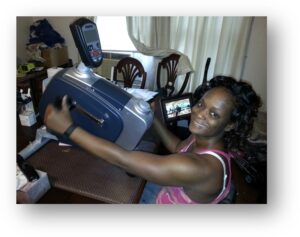
TExT-ME (Telehealth Exercise Training for Monitoring and Evaluation of Home-Based Exercise in People with Neuromuscular Disability) is an exercise training and monitoring system using a customized platform to conduct high-fidelity, safe and effective training studies. The platform consists of a “coach’s station” website that connects to a customized application on an Android tablet. This allows the coach and participant to communicate via live-time video conferencing as well as text message. Additionally, TExT-ME utilizes a BioharnessTM 3 physiological monitor that sends live heart rate and respiratory rate data to the tablet and coach’s station to allow for safe and effective monitoring of the exercise session. Each training session is stored on the website and can be exported for further data analysis. Exercise protocols and participant and coach information are also stored on the coach’s website.
Why is TExT-ME being developed?
The TExT-ME system is being developed to provide a home-based exercise training option for people with spinal cord injury (SCI) and other conditions, which could serve both therapy and research initiatives. The current exercise training literature on people with SCI is limited by small sample sizes, high dropout rates, under-dosed training programs, and selection bias associated with study participants who have transportation, are higher functioning, and are more motivated to devote time and energy traveling to and from an exercise site several days per week (1-3). Home-based telehealth holds promise as an effective method for conducting exercise trials on hard-to-reach populations by eliminating the barrier of transportation, offering participants the flexibility of exercising at their preferred time of day, and conserving energy and time associated with travel.
How is this system being developed?
We worked with collaborators at Innovare Care and the University of Alabama at Huntsville to finalize the customized Android application and coach’s website. We then tested the usability of the system in three individuals with SCI during a single bout of aerobic exercise on the arm ergometer in a fitness facility.
Related Videos
Related Publication
Teleexercise for Persons With Spinal Cord Injury
References
- Rimmer JH, Chen MD, McCubbin JA, Drum C, Peterson J. Exercise intervention research on persons with disabilities: what we know and where we need to go. American journal of physical medicine & rehabilitation / Association of Academic Physiatrists. 2010;89(3):249-63. Epub 2010/01/14. doi: 10.1097/PHM.0b013e3181c9fa9d. PubMed PMID: 20068432.
- Ginis KA, Hicks AL. Exercise research issues in the spinal cord injured population. Exercise and sport sciences reviews. 2005;33(1):49-53. Epub 2005/01/11. PubMed PMID: 15640721.
- Ginis KA, Hicks AL. Considerations for the development of a physical activity guide for Canadians with physical disabilities. Canadian journal of public health = Revue canadienne de sante publique. 2007;98 Suppl 2:S135-47. Epub 2008/01/25. PubMed PMID: 18213944.
ASTM UDFE Data Form
The ASTM F3021/F3022 UDFE/IF Data Form will be used to collect data and report results on strength and aerobic equipment designed to meet the ASTM F3021 and F3022 standards for Universal Design of Fitness Equipment (UDFE)/Inclusive Fitness (IF).
http://www.rectech.org/wp-content/uploads/2014/09/UDFE.pdf
